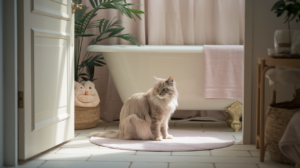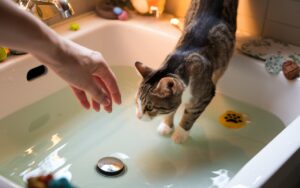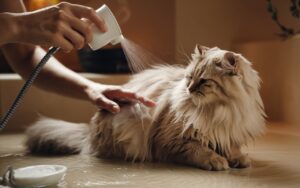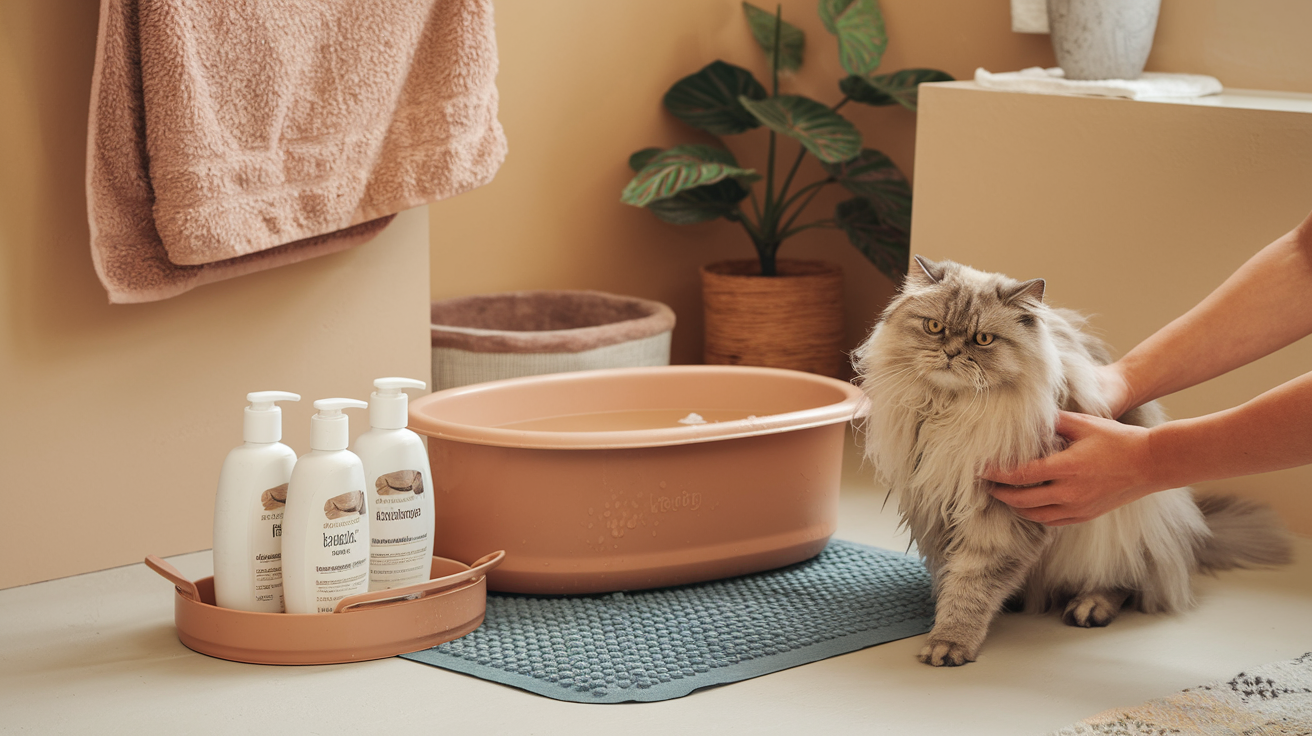Many cat owners have noticed that their feline companions tend to avoid water at all costs. This aversion is a key consideration for anyone wondering How to Bathe a Cat That Hates Water? It is deeply ingrained in most cats, stemming from their evolutionary background. Unlike some animals that thrive in aquatic environments, cats’ coats don’t naturally repel water, making them uncomfortable when wet. Additionally, the sensation of water can feel foreign to them, and the noise or sudden splash might trigger anxiety.
Despite cats’ tendency to self-groom meticulously, there are instances when a full bath is necessary. Whether due to dirt, oil buildup, or medical conditions, maintaining proper hygiene is crucial to a cat’s overall health. While their rough tongues do a great job of daily maintenance, a deeper cleanse is sometimes needed to tackle grime or allergens that can accumulate over time.
The goal of this article is to guide you through the process of bathing a cat that despises water. With these step-by-step instructions, you’ll learn how to keep your cat clean in a safe, stress-free, and efficient manner, ensuring both you and your furry friend emerge from the experience unscathed.
Preparation Before the Bath
Gather Supplies
Before introducing your cat to water, proper preparation is essential for making the experience as smooth as possible. Start by gathering all the necessary supplies to ensure everything you need is within arm’s reach. You’ll need a cat-specific shampoo, as human products can irritate their sensitive skin. Grab a couple of towels—one to dry your cat and another to help with any potential mess. A non-slip mat for the bathtub or sink is also a must to keep your cat stable and avoid slipping. Lastly, have some of your cat’s favorite treats handy to reward good behavior throughout the process.

Create a Calm Environment
Next, it’s important to create a calm and distraction-free environment. Cats are highly sensitive to their surroundings, and sudden noises or movements can cause them to panic. Close the door to the bathroom to prevent your cat from escaping, and make sure there are no loud sounds that could trigger anxiety. A peaceful setting will help keep your cat relaxed and more cooperative during the bath.

Brush Your Cat First
Before you even think about water, give your cat a thorough brushing to remove loose hair and tangles. This will prevent matting, which can worsen once their fur is wet. It’s a good opportunity to bond with your cat as well, making the process less stressful for them.

Clip Nails
It’s also wise to clip your cat’s nails beforehand, as they might react defensively during the bath. A quick trim will minimize the chances of scratches, keeping both you and your cat safe throughout the process.

Consider Alternatives to a Full Bath
While a full bath may be necessary in some situations, there are alternatives that can effectively clean your cat without the stress of water. One popular option is dry shampoo, specifically formulated for cats. These products come in various forms, such as powders or sprays, and they work by absorbing oils and dirt from your cat’s fur. To use dry shampoo, simply sprinkle or spray the product onto your cat’s coat, then gently rub it in with your hands or a soft brush. After allowing it to sit for a few moments, you can brush it out, leaving your cat’s fur looking fresh and clean without the need for water.
Another simple method for mild cleaning needs is a damp cloth wipe-down. This technique involves taking a soft, damp cloth and gently wiping your cat’s fur to remove dirt or loose hair. Focus on areas that tend to accumulate grime, like the paws, belly, and around the eyes. This approach is particularly useful for cats that may have gotten into something messy or have dust on their fur but don’t require a full bath. It’s quick, easy, and minimizes stress for your cat.
Finally, pet wipes are another convenient option for cleaning your cat. These pre-moistened wipes are specially designed for pet use, often containing gentle ingredients that are safe for your cat’s skin. Simply grab a wipe and gently clean your cat’s coat, focusing on any specific spots that need attention. Pet wipes are especially handy for quick clean-ups between baths, making them a great addition to your grooming routine. Whether you choose dry shampoo, a damp cloth, or pet wipes, these alternatives can keep your cat looking and feeling clean without the fuss of a full bath.
Gradual Introduction to Water
When it comes to bathing a cat that dislikes water, a gradual introduction is key to ensuring a positive experience. Start by using small amounts of water in a sink or tub. Fill the basin with just a couple of inches of lukewarm water to create a comfortable environment. This limited exposure helps to avoid overwhelming your cat, allowing them to acclimate to the sensation without feeling submerged. Let your cat explore the water at their own pace, encouraging them to step closer and sniff the surface before attempting any bathing.

As you begin this process, it’s essential to help your cat get used to the sound and feel of water. Before you introduce them to the bath, try playing with water near them, such as splashing a bit or letting them watch you fill the sink. This exposure can help demystify water and reduce anxiety. Additionally, you can use toys or treats to distract them and create a positive association with water. If they seem anxious, take breaks and give them plenty of affection to reinforce that they are safe. The goal is to make the experience as calm and reassuring as possible.
The water’s temperature is another important consideration. Cats are particularly sensitive to temperature, so using lukewarm water is essential for their comfort. Water that is too hot or too cold can be shocking and lead to a negative bathing experience. Ideally, the water should feel warm to your touch but not hot, similar to the temperature you might use for a baby. Ensuring a comfortable temperature will help your cat feel more at ease during the bath and make the process smoother for both of you.
Gentle Bathing Process
Once your cat is accustomed to the water, it’s time to begin the bathing process. Here’s a step-by-step guide to ensure a gentle and effective bath for your feline friend. Start by wetting your cat slowly. Use a cup or a sprayer set to a low setting to control the flow of water. Begin at the back of the cat, gradually moving toward the front. This helps prevent sudden splashes that can startle them. Make sure to avoid the face and ears during this initial wetting to reduce any fear they might have of water getting into sensitive areas.

After your cat is thoroughly wet, it’s time to apply shampoo. Use a cat-specific shampoo and apply a small amount to your hands, then lather it gently into your cat’s fur. Pay attention to areas that may need extra cleaning, such as the paws, belly, and tail. Be sure to keep your touch light and soothing, as this will help your cat feel more comfortable. Rinse thoroughly with clean, lukewarm water, again avoiding the face and ears. Ensure all the shampoo is washed out, as the leftover product can irritate their skin.
If your cat starts to struggle during the bath, it’s essential to remain calm. To help calm their fears, speak to them in a soothing tone and with kind assurance. Keeping a calm demeanor not only helps your cat relax but also sets the tone for the entire bathing experience. Avoid restraining your cat too much; instead, let them find their own comfortable position while gently guiding them if necessary. If they continue to resist, consider taking breaks and returning to the bath later. Patience is key, as a gentle approach will lead to a more successful and less stressful bathing process for both you and your cat.
Drying Your Cat
After the bath, drying your cat is the next important step, and it should be done with care. Start by using a towel to gently pat your cat dry. Instead of rubbing vigorously, which can cause discomfort and may tangle their fur, softly blot the water away. Focus on areas that tend to hold more moisture, such as the belly, paws, and underarms. Your cat might still be a bit anxious after the bath, so handling them gently and calmly will help maintain a positive experience.

It’s essential to avoid using hair dryers to dry your cat. While the idea of a quick blow-dry might seem efficient, there are several risks involved. Firstly, the noise of a hair dryer can be frightening for cats, causing them to feel stressed and anxious. The sound might trigger a flight response, making them more agitated than they already are. Additionally, hair dryers can get quite hot, and if held too close to your cat’s skin, they risk overheating. This can lead to burns or discomfort. Instead, stick to towel drying and allow your cat to air dry in a warm, quiet room. This approach is safer and more soothing, ensuring your cat feels comfortable and secure after their bath.
Post-Bath Rewards
After the bath, it’s crucial to help your cat associate the experience with positive feelings. Positive reinforcement plays a vital role in this process. As soon as you finish drying your cat, offer them their favorite treats and plenty of praise. This can significantly reduce any lingering stress from the bath, helping them connect the experience with something enjoyable. By rewarding your cat immediately after the bath, you encourage them to view future baths in a more favorable light, making the process easier over time.
In addition to treats and praise, creating a cozy space for your cat to relax in is essential. After the bath, your cat may feel a bit vulnerable, so providing a warm, quiet area where they can unwind will help them feel secure. Set up a soft blanket or a comfortable bed in a peaceful corner of your home, away from the hustle and bustle. You might even consider adding a warm heat source, like a heating pad set on low, to make the area even more inviting. Allow your cat to choose when they want to leave this cozy retreat, giving them the freedom to relax and regroup after the bath. This thoughtful approach not only helps to ease any anxiety but also reinforces the idea that they are safe and loved, making future bathing experiences more manageable.
Extra Tips for Nervous Cats
For cats that are particularly nervous about water, it’s important to recognize when extra support is needed. If bathing your cat at home feels too challenging, consider professional grooming. Groomers are trained to handle cats and often have techniques to manage their anxiety effectively. Both you and your cat will have a more comfortable experience if a professional creates a quiet controlled setting. Additionally, groomers have access to specialized equipment and products that can help make the bathing process quicker and less stressful.
Another helpful strategy is to use a partner during bath time. Having someone assist you can be beneficial, especially if your cat tends to struggle. One person can hold and gently soothe the cat, while the other manages the bathing process. This extra set of hands can make it easier to keep your cat calm and prevent them from escaping. The presence of a second person can also provide reassurance to your cat, making them feel less isolated during what may be a stressful experience.
If your cat experiences extreme anxiety about baths or water, it’s a good idea to consult your vet. Your veterinarian can offer valuable insights and may recommend specific strategies or products, such as calming sprays or medications, to help reduce anxiety. Understanding the root of your cat’s fear is crucial, and a professional can guide you toward the best approach to support your feline friend. By taking these extra steps, you can ensure that your cat feels more comfortable during bathing and grooming sessions, ultimately leading to a more pleasant experience for both of you.
Conclusion
In conclusion, successfully bathing a water-hating cat requires careful preparation, patience, and a deep understanding of your cat’s individual limits. From gathering the right supplies and creating a calm environment to gradually introducing them to water, each step is essential in making the experience as smooth as possible. Remember that every cat is unique, and recognizing their comfort levels will help you tailor the bathing process to their needs.
It’s vital to keep the entire bathing process as stress-free as possible. Maintaining a calm demeanor, using gentle techniques, and allowing your cat to acclimate at their own pace will go a long way in reducing anxiety. Always prioritize your cat’s comfort, and don’t hesitate to take breaks or seek alternative cleaning methods if they show signs of distress.
Finally, always end each bathing session on a positive note by praising and rewarding your cat. Offering treats and affection after each successful bath reinforces the idea that baths can lead to pleasant outcomes. With patience and practice, you can turn bathing into a more manageable and even enjoyable experience for both you and your beloved feline companion.
FAQs
Why do cats dislike water?
Cats generally dislike water due to their evolutionary background. Unlike some animals, cats are not natural swimmers, and their fur is not designed to get wet. Additionally, many cats are sensitive to changes in temperature and texture, making the feeling of water uncomfortable for them. This aversion can lead to stress during bathing.
How often should I bathe my cat?
The vast majority of cats are excellent groomers and do not need to be washed frequently. A bath is typically recommended every few months, or when they get into something particularly dirty or smelly. However, cats with certain health conditions or those who are older and less mobile may need more regular bathing assistance.
Can I use human shampoo on my cat?
No, you should avoid using human shampoo on cats, as it can irritate their skin and disrupt their natural pH balance. Instead, use a shampoo specifically formulated for cats, which is designed to be gentle and safe for their skin and fur.
What should I do if my cat fights during the bath?
If your cat becomes aggressive or overly stressed during the bath, it’s best to remain calm and stop the process. Take a break, allow your cat to relax, and try again later. You might also consider consulting a professional groomer or your veterinarian for advice on managing your cat’s anxiety.
Are there alternatives to bathing my cat?
Yes, there are several alternatives to a full bath. You can use a dry shampoo specifically made for cats, perform a damp cloth wipe-down, or utilize pet wipes for quick cleaning. These methods can effectively remove dirt and odors without the stress of a water bath.
How can I make bath time more enjoyable for my cat?
To make bath time more enjoyable, create a calm and inviting environment. Use positive reinforcement, such as treats and praise, to reward your cat during and after the bath. Let your cat explore the bath area at their own speed and gradually add water.
What if my cat has extreme anxiety about water?
If your cat shows extreme anxiety towards water, consult your veterinarian. They can provide recommendations for calming techniques, behavior modification strategies, or even medication to help ease your cat’s stress during bath time.
